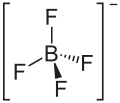Lithium tetrafluoroborate
| |||
| Names | |||
|---|---|---|---|
| IUPAC name
Lithium tetrafluoroborate | |||
| Other names
Borate(1-), tetrafluoro-, lithium | |||
| Identifiers | |||
| 14283-07-9 | |||
| 3D model (Jmol) | Interactive image | ||
| ChemSpider | 3504162 | ||
| ECHA InfoCard | 100.034.692 | ||
| PubChem | 4298216 | ||
| |||
| |||
| Properties | |||
| LiBF4 | |||
| Molar mass | 93.746 g/mol | ||
| Appearance | White/grey crystalline solid | ||
| Odor | odorless | ||
| Density | 0.852 g/cm3 solid | ||
| Melting point | 296.5 °C (565.7 °F; 569.6 K) | ||
| Boiling point | decomposes | ||
| Very soluble[1] | |||
| Hazards | |||
| Main hazards | Harmful, causes burns, hygroscopic. | ||
| Safety data sheet | External MSDS | ||
| NFPA 704 | |||
| Related compounds | |||
| Other anions |
Tetrafluoroborate, | ||
| Related compounds |
Nitrosyl tetrafluoroborate | ||
| Except where otherwise noted, data are given for materials in their standard state (at 25 °C [77 °F], 100 kPa). | |||
| | |||
| Infobox references | |||
Lithium tetrafluoroborate is an inorganic compound with the formula LiBF4. It is a white crystalline powder. It has been extensively tested for use in commercial secondary batteries, an application that exploits its high solubility in nonpolar solvents.[2]
Applications
Although BF4− has high ionic mobility, solutions of its Li+ salt are less conductive than other less associated salts.[2] As an electrolyte in Lithium-ion batteries, LiBF4 offers some advantages relative to the more common LiPF6. It exhibits greater thermal stability[3] and moisture tolerance.[4] For example, LiBF4 can tolerate a moisture content up to 620 ppm at room temperature whereas LiPF6 readily hydrolyzes into toxic POF3 and HF gases, often destroying the battery's electrode materials. Disadvantages of the electrolyte include a relatively low conductivity and difficulties forming a stable solid electrolyte interface with graphite electrodes.
Thermal stability
Because LiBF4 and other alkali-metal salts thermally decompose to evolve boron trifluoride, the salt is commonly used as a convenient source of the chemical at the laboratory scale:[5]
Production
LiBF4 is a byproduct in the industrial synthesis of diborane:[5][6]
LiBF4 can also be synthesized from LiF and BF3 in an appropriate solvent that is resistant to fluorination by BF3 (e.g. HF, BrF3, or liquified SO2):[5]
- LiF + BF3 → LiBF4
References
- ↑ GFS-CHEMICALS
- 1 2 Xu, Kang. "Nonaqueous Liquid Electrolytes for Lithium-Based Rechargeable Batteries."Chemical Reviews 2004, volume 104, pp. 4303-418. doi:10.1021/cr030203g
- ↑ S. Zhang; K. Xu; T. Jow (2003). "Low-temperature performance of Li-ion cells with a LiBF4-based electrolyte" (PDF). Journal of Solid State Electrochemistry. 7 (3): 147–151. doi:10.1007/s10008-002-0300-9. Retrieved 16 February 2014.
- ↑ S. S. Zhang; z K. Xu & T. R. Jow (2002). "Study of LiBF4 as an Electrolyte Salt for a Li-Ion Battery" (PDF). Journal of The Electrochemical Society. 149 (5): A586–A590. doi:10.1149/1.1466857. Retrieved 16 February 2014.
- 1 2 3 Robert, Brotherton; Joseph, Weber; Clarence, Guibert & John, Little (2000). "Boron Compounds". Ullmann's Encyclopedia of Industrial Chemistry: pg. 10. doi:10.1002/14356007.a04_309.
- ↑ Brauer, Georg (1963). Handbook of Preparative Inorganic Chemistry Vol. 1, 2nd Ed. Newyork: Academic Press. p. 773. ISBN 978-0121266011.


